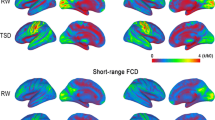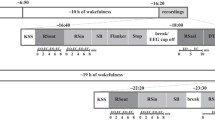Abstract
Several functional imaging studies have investigated the regional effects of sleep deprivation (SD) on impaired brain function; however, potential changes in the functional interactions between the cerebral hemispheres after SD are not well understood. In this study, we used a recently validated approach, voxel-mirrored homotopic connectivity (VMHC), to directly examine the changes in interhemispheric homotopic resting-state functional connectivity (RSFC) after SD. Resting-state functional MRI (fMRI) was performed in 28 participants both after rest wakefulness (RW) and a total night of SD. An interhemispheric RSFC map was obtained by calculating the Pearson correlation (Fisher Z transformed) between each pair of homotopic voxel time series for each subject in each condition. The between-condition differences in interhemispheric RSFC were then examined at global and voxelwise levels separately. Significantly increased global VMHC was found after sleep deprivation; specifically, a significant increase in VMHC was found in specific brain regions, including the thalamus, paracentral lobule, supplementary motor area, postcentral gyrus and lingual gyrus. No regions showed significantly reduced VMHC after sleep deprivation. Further analysis indicates that these findings did not depend on the various sizes of smoothing kernels that were adopted in the preprocessing steps and that the differences in these regions were still significant with or without global signal regression. Our data suggest that the increased VMHC might reflect the compensatory involvement of bilateral brain areas, especially the bilateral thalamus, to prevent cognitive performance deterioration when sleep pressure is elevated after sleep deprivation. Our findings provide preliminary evidence of interhemispheric correlation changes after SD and contribute to a better understanding of the neural mechanisms of SD.






Similar content being viewed by others
References
Achermann, P., Finelli, L. A., & Borbély, A. A. (2001). Unihemispheric enhancement of delta power in human frontal sleep EEG by prolonged wakefulness. Brain Research, 913, 220–223.
Boonstra, T., Stins, J., Daffertshofer, A., & Beek, P. (2007). Effects of sleep deprivation on neural functioning: an integrative review. Cellular and Molecular Life Sciences, 64, 934–946.
Chao-Gan, Y., Yu-Feng, Z., 2010. DPARSF: a MATLAB toolbox for “pipeline” data analysis of resting-state fMRI. Frontiers in systems neuroscience, 4, 13.
Chee, M. W., & Choo, W. C. (2004). Functional imaging of working memory after 24 hr of total sleep deprivation. The Journal of Neuroscience., 24, 4560–4567.
Chee, M. W., & Chuah, L. Y. (2008). Functional neuroimaging insights into how sleep and sleep deprivation affect memory and cognition. Current Opinion in Neurology, 21, 417–423.
Chee, M. W., & Tan, J. C. (2010). Lapsing when sleep deprived: neural activation characteristics of resistant and vulnerable individuals. NeuroImage, 51, 835–843.
Chee, M. W., Tan, J. C., Zheng, H., Parimal, S., Weissman, D. H., Zagorodnov, V., et al. (2008). Lapsing during sleep deprivation is associated with distributed changes in brain activation. The Journal of Neuroscience., 28, 5519–5528.
Chee, M. W., Tan, J. C., Parimal, S., & Zagorodnov, V. (2010). Sleep deprivation and its effects on object-selective attention. NeuroImage, 49, 1903–1910.
De Havas, J. A., Parimal, S., Soon, C. S., & Chee, M. W. (2012). Sleep deprivation reduces default mode network connectivity and anti-correlation during rest and task performance. NeuroImage, 59, 1745–1751.
Durmer, J.S., Dinges, D.F., 2005. Neurocognitive consequences of sleep deprivation. In Seminars in neurology, 25, 117–129.
Fox, M. D., Zhang, D., Snyder, A. Z., & Raichle, M. E. (2009). The global signal and observed anticorrelated resting state brain networks. Journal of Neurophysiology., 101, 3270–3283.
Gujar, N., Yoo, S.-S., Hu, P., & Walker, M. P. (2011). Sleep deprivation amplifies reactivity of brain reward networks, biasing the appraisal of positive emotional experiences. The Journal of Neuroscience., 31, 4466–4474.
Horne, J. A., & Ostberg, O. (1975). A self-assessment questionnaire to determine morningness-eveningness in human circadian rhythms. International Journal of Chronobiology, 4, 97–110.
Kattler, H., Dijk, D. J., & Borbély, A. A. (1994). Effect of unilateral somatosensory stimulation prior to sleep on the sleep EEG in humans. Journal of Sleep Research, 3, 159–164.
Kelly, C., Zuo, X.-N., Gotimer, K., Cox, C. L., Lynch, L., Brock, D., et al. (2011). Reduced interhemispheric resting state functional connectivity in cocaine addiction. Biological Psychiatry, 69, 684–692.
Li, H. J., Xu, Y., Zhang, K. R., Hoptman, M. J., & Zuo, X. N. (2015). Homotopic connectivity in drug-naïve, first-episode, early-onset schizophrenia. Journal of Child Psychology and Psychiatry, 56, 432–443.
Lim, J., & Dinges, D. F. (2008). Sleep deprivation and vigilant attention. Annals of the New York Academy of Sciences, 1129, 305–322.
Ma, N., Dinges, D. F., Basner, M., & Rao, H. (2015). How acute total sleep loss affects the attending brain: a meta-analysis of neuroimaging studies. Sleep, 38, 233–240.
Rocklage, M., Williams, V., Pacheco, J., & Schnyer, D. M. (2009). White matter differences predict cognitive vulnerability to sleep deprivation. Sleep, 32, 1100.
Song, X.-W., Dong, Z.-Y., Long, X.-Y., Li, S.-F., Zuo, X.-N., Zhu, C.-Z., et al. (2011). REST: a toolkit for resting-state functional magnetic resonance imaging data processing. PloS One, 6, e25031.
Steriade, M., & Llinás, R. R. (1988). The functional states of the thalamus and the associated neuronal interplay. Physiological Reviews, 68, 649–742.
Thomas, M., Sing, H., Belenky, G., Holcomb, H., Mayberg, H., Dannals, R., et al. (2000). Neural basis of alertness and cognitive performance impairments during sleepiness. I. Effects of 24 h of sleep deprivation on waking human regional brain activity. Journal of Sleep Research, 9, 335–352.
Van Dongen, H. P., Maislin, G., Mullington, J. M., & Dinges, D. F. (2003). The cumulative cost of additional wakefulness: dose-response effects on neurobehavioral functions and sleep physiology from chronic sleep restriction and total sleep deprivation. Sleep, 26, 117–126.
Wu, J. C., Gillin, J. C., Buchsbaum, M. S., Chen, P., Keator, D. B., Wu, N. K., et al. (2006). Frontal lobe metabolic decreases with sleep deprivation not totally reversed by recovery sleep. Neuropsychopharmacology, 31, 2783–2792.
Xu, J., Zhu, Y., Fu, C., Sun, J., Li, H., Yang, X., et al. (2015). Frontal metabolic activity contributes to individual differences in vulnerability toward total sleep deprivation-induced changes in cognitive function. Journal of sleep research.
Yeo, B. T., Tandi, J., & Chee, M. W. (2015). Functional connectivity during rested wakefulness predicts vulnerability to sleep deprivation. NeuroImage, 111, 147–158.
Yuan, K., Qin, W., Liu, P., Zhao, L., Yu, D., Zhao, L., et al. (2012). Reduced fractional anisotropy of corpus callosum modulates inter-hemispheric resting state functional connectivity in migraine patients without aura. PloS One, 7, e45476.
Zhou, G., Liu, P., Zeng, F., Yuan, K., Yu, D., Deneen, K. M., et al. (2013). Increased interhemispheric resting-state functional connectivity in functional dyspepsia: a pilot study. NMR in Biomedicine, 26, 410–415.
Zuo, X.-N., & Xing, X.-X. (2014). Test-retest reliabilities of resting-state FMRI measurements in human brain functional connectomics: a systems neuroscience perspective. Neuroscience and Biobehavioral Reviews, 45, 100–118.
Zuo, X.-N., Kelly, C., Di Martino, A., Mennes, M., Margulies, D. S., Bangaru, S., et al. (2010). Growing together and growing apart: regional and sex differences in the lifespan developmental trajectories of functional homotopy. The Journal of Neuroscience., 30, 15034–15043.
Author information
Authors and Affiliations
Corresponding author
Ethics declarations
Funding
This study was financially supported by National Basic Research Program of China under Grant Nos. 2015CB856403, 2014CB543203 and 2012CB518501, the National Natural Science Foundation of China under Grant Nos. 81271644, 81471811, 81471738, 61401346, 81271534, 81160452 and 31200837, and the Fundamental Research Funds for the Central Universities.
Conflict of interest
All authors have indicated no financial conflicts of interest.
Ethical approval
All procedures performed in studies involving human participants were in accordance with the ethical standards of the People’s Hospital of Zhengzhou University Subcommittee and with the 1964 Helsinki declaration and its later amendments or comparable ethical standards.
Informed consent
Informed consent was obtained from all individual participants included in the study.
Disclosure statement
This was not an industry supported study. The authors have indicated no financial conflicts of interest.
Rights and permissions
About this article
Cite this article
Zhu, Y., Feng, Z., Xu, J. et al. Increased interhemispheric resting-state functional connectivity after sleep deprivation: a resting-state fMRI study. Brain Imaging and Behavior 10, 911–919 (2016). https://doi.org/10.1007/s11682-015-9490-5
Published:
Issue Date:
DOI: https://doi.org/10.1007/s11682-015-9490-5




